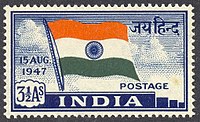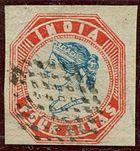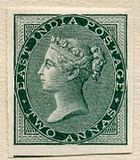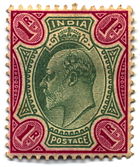http://en.wikipedia.org/wiki/Postage_stamps_and_postal_history_of_India
Postage stamps and postal history of India
From Wikipedia, the free encyclopedia

The first stamp of independent India shows the new Indian Flag. It was meant for foreign correspondence.[1][2]

The second stamp depicts the Aśokan lions capital, the national emblem of India, and is for domestic use.[1][2]
The postal systems in India existed in various forms from before the Christian era. As the Portuguese, Dutch, French, Danish and British displaced the Mughals, their postal systems existed alongside those of nominally independent states. The British East India Company gradually displaced other powers and brought into existence a British administrative system all over India, with a need to establish and maintain official mail systems. The Indian Post Office, which was established in 1837, introduced the first Asian adhesive stamp, the Scinde Dawk, in 1852. The Indian postal system developed into an extensive, dependable and robust network providing connectivity to almost all parts of India, Burma, the Straits Settlements and other areas controlled by the British East India Company. Based on the model postal system introduced in England by the reformer, Rowland Hill, postal services were provided at a low cost and enabled the smooth functioning of the administrative machinery of the British Raj. The Imperial Posts co-existed with the several postal systems maintained by various Indian states, some of which produced stamps for use within their respective dominions, while British Indian postage stamps were required for sending mail beyond the boundaries of these states. Telegraphy and telephony made their appearance as part of the Posts before becoming separate departments. After the Independence of India in 1947, the Indian postal service continues to function on a countrywide basis and provides many valuable, low cost services to the public of India.
Postal history of India
The Post in ancient and medieval India
The history of India's postal system begins long before the introduction of postage stamps. The antecedents have been traced to the systems of the Persian Empire instituted by Cyrus the Great and Darius I for communicating important military and political information. The Atharvaveda records a messenger service. Systems for collecting information and revenue data from the provinces are mentioned in Chanakya's Arthashastra (ca. 3rd century BC).
In ancient times the kings, emperors, rulers, zamindars or the feudal lords protected their land through the intelligence services of specially trained police or military agencies and courier services to convey and obtain information through runners, messengers and even through pigeons. The chief of the secret service, known as the postmaster, maintained the lines of communication ... The people used to send letters to [their] distant relatives through their friends or neighbors.[3]
For centuries it was rare for messages to be carried by any means other than a relay of runners on foot. A runner ran from one village or relay post to the next, carrying the letters on a pole with a sharp point. His was a dangerous occupation: the relay of postal runners worked throughout the day and night, vulnerable to attacks by bandits and wild animals. These mail runners were used chiefly by the rulers, for purposes of information and wartime news. They were subsequently used by merchants for trade purpose. It was much later that mail runners came to be in use for the carriage of private mail.
The postal history of India primarily began with the overland routes, stretching from Persia to India. What began as mere foot-tracks that more than often included fords across the mountaneous streams, gradually evolved over the centuries as highways, used by traders and military envoys on foot and horses, for carriage of missives.
The Arab influence of the Caliphate came about with the conquest of Sind by Muhammad bin Qasim in 712 A.D. Thereupon, the Diwan-i-Barid or Department of Posts established official communication across the far-flung empire. The swiftness of the horse messengers finds mention in many of the chronicles of that period.
The first Sultan of Delhi, Qutb-ud-din Aybak (Persian: قطب الدین ایبک) was Sultan for only four years, 1206 - 1210, but he founded the Mamluk Dynasty and created a messenger post system. This was expanded into the dak chowkis, a horse and foot runner service, by Alauddin Khilji in 1296. Sher Shah Suri (1541-1545) replaced runners with horses for conveyance of messages along the northern high road, today known as the Grand Trunk Road, which he constructed between Bengal and Sindh over an ancient trade route at the base of the Himalayas, the Uttarapatha. He also built 1700 'serais' where two horses were always kept for the despatch of the Royal Mail[4] Akbar introduced camels in addition to the horses and runners.[4]
In the South of India, in 1672 Raja Chuk Deo of Mysore began an efficient postal service which was further improved upon by Haider Ali.[4]
Posts and the East India Company
The East India Company took constructive steps to improve the existing systems in India when in 1688, they opened a post office in Bombay followed by similar ones in Calcutta and Madras. Lord Clive further expanded the services in 1766 and in 1774 Warren Hastings made the services available o the general public. The fee charge was two annas per 100 miles.[4]
The postmarks applied on these letters are very rare and are named 'Indian Bishop Marks' after Colonel Henry Bishop, the Postmaster General of the United Kingdom who introduced this practice in Britain.[4]
After 1793, when Cornwallis introduced the Regulation of the Permanent Settlement, the financial responsibility for maintaining the official posts rested with the zamindars. Alongside these, private dawk mail systems sprang up for the commercial conveyance of messages using hired runners. Also, the East India Company created its own infrastructure for the expansion and administration of military and commercial power. The runners were paid according to the distance they travelled and the weight of their letters.
The Post Office Act XVII of 1837 provided that the Governor-General of India in Council had the exclusive right of conveying letters by post for hire within the territories of the East India Company. The mails were available to certain officials without charge, which became a controversial privilege as the years passed. On this basis the Indian Post Office was established on October 1, 1837.[5]
The urgent European mails were carried overland via Egypt at the isthmus of Suez. This route, pioneered by Thomas Waghorn[6], linked the Red Sea with the Mediterranean, and thence by steamer via Marseilles, Brindisi or Trieste to European destinations. The Suez Canal did not open until much later (17 November, 1869). The time in transit for letters using the Overland Mail [7] route was dramatically reduced. Waghorn's route reduced the journey from 16,000 miles via the Cape of Good Hope to 6,000 miles; and reduced the time in transit from three months to between 35 and 45 days.
The Scinde District Dawk
The use of the Scinde Dawk adhesive stamps to signify the prepayment of postage began on 1 July 1852 in the Scinde/Sindh district,[8] as part of a comprehensive reform of the district's postal system. A year earlier Sir Bartle Frere had replaced the postal runners with a network of horses and camels, improving communications in the Indus river valley to serve the military and commercial needs of the British East India Company.[9]
The new stamps were embossed individually onto paper or a wax wafer. The shape was circular, with "SCINDE DISTRICT DAWK" around the rim and the British East India Company's Merchant's Mark as the central emblem. The paper was either white or greyish white. The blue stamp was printed onto the paper by the die during the embossing, while the wax version was embossed on a red sealing wax wafer on paper; but all had the same value of 1/2 anna. They were used until October 1854, and then officially suppressed. These are quite scarce today, with valuations from US$700 to $10,000 for postally used examples. The unused red stamp was previously valued at £65,000.00 by Stanley Gibbons (basis 2006); however, it now appears that no unused examples have survived.
The Reforms of 1854 and the First Issues
The first stamps valid for postage throughout India were placed on sale in October, 1854 with four values: 1/2 anna, 1 anna, 2 annas, and 4 annas.[10] Featuring a youthful profile of Queen Victoria aet. 15 years, all four values were designed and printed in Calcutta. All were lithographed except for the 2 annas green, which was produced by typography from copper clichés or from electrotyped plates. These were issued without perforations or gum. The 4 annas value (illustrated) was one of the world's first bicolored stamps, preceded only by the Basel Dove, a beautiful local issue.
These stamps were issued following a Commission of Inquiry which had carefully studied the postal systems of Europe and America. In the opinion of Geoffrey Clarke, the reformed system was to be maintained "for the benefit of the people of India and not for the purpose of swelling the revenue."[11] The Commissioners voted to abolish the earlier practice of conveying official letters free of postage ("franking"). The new system was recommended by the Governor-General, Lord Dalhousie and adopted by the East India Company's Court of Directors. It introduced "low and uniform" rates for sending mail efficiently throughout the country within the jurisdiction of the East India Company. The basic rate was 1/2 anna on letters not more than 1/4 tola in weight. The stamps were needed to show the postage was prepaid, a basic principle of the new system, like the fundamental changes of the British system advocated by Rowland Hill and the Scinde reforms of Bartle Frere. These reforms transformed mail services within India.
The East India Company already had attempted a 1/2 anna vermilion stamp in April, 1854, known as the "9 1/2 arches essay". This could not be produced in quantity because it required an expensive vermilion pigment not readily available from England, and the substituted Indian pigment destroyed the printing stones.
A new design for stamps, with Queen Victoria in an oval vignette inside a rectangular frame, was inscribed "EAST INDIA POSTAGE". These stamps were recess printed by De La Rue in England (who produced all the subsequent issues of British India until 1925)[12]. The first of these became available in 1855. They continued in use well after the British government took over the administration of India in 1858, following the 1857 Rebellion against the East India Company's rule. From 1865 the Indian stamps were printed on paper watermarked with an elephant's head.
The Reforms of 1866 and the Provisionals
The volume of mail moved by the postal system increased relentlessly, doubling between 1854 and 1866, then doubling again by 1871. The Post Office Act XIV introduced reforms by May 1, 1866 to correct some of the more apparent postal system deficiencies and abuses. Postal service efficiencies also were introduced. In 1863 new lower rates were set for "steamer" mail to Europe at 6 annas 8 pies for a 1/2 ounce letter. Lower rates were introduced for inland mail, as well.
New regulations removed the special postal privileges which had been enjoyed by officials of the East India Company. Stamps for official use were prepared and carefully accounted for to combat the abuse of privileges by officials. In 1854 Spain had printed special stamps for official communications, but in 1866 India was the first country to adopt the simple expedient of overprinting 'Service' on postage stamps and 'Service Postage' on revenue stamps. This innovation became widely adopted by other countries in later years[13][14].
Shortages developed, so these stamps also had to be improvised. Some of the "Service Postage" overprinted rarities of this year resulted from the sudden changes in postal regulations. New designs for the 4 annas and "6 annas 8 pies" stamps were issued in 1866. Nevertheless, there was a shortage of stamps to meet the new rates. Provisional[15] six annas stamps were improvised by cutting the tops and bottoms from a current Foreign Bill revenue stamp, and overprinting "POSTAGE".
Another four new designs appeared, one at a time, between 1874 and 1876.
A complete new set of stamps was issued in 1882 for the Empire of India that had been proclaimed five years earlier, in 1877. The designs consisted of the usual Victoria profile, in a variety of frames, inscribed "INDIA POSTAGE". The watermark also changed to a star shape. These stamps were heavily used and are still quite common today.
Twentieth century
High values -- 2, 3 and 5 rupees -- were introduced in 1895. Other existing designs were reprinted in new colors in 1900.
In 1902 a new series depicting King Edward VII generally reused the frames of the Victoria stamps, with some color changes, and included values up to 25 rupees. The higher values were often used for the payment of telegraph and parcel fees. Generally, such usage will lower a collector's estimation of a stamp's value; except those from remote or "used abroad" offices.[16]
The 1911 stamps of King George V were more florid in their design. It is reported that George V, a philatelist, personally approved these designs. In 1919 a 1 1/2 anna stamp was introduced, inscribed "ONE AND HALF ANNA", but in 1921 this changed to "ONE AND A HALF ANNAS". In 1926 the watermark changed to a pattern of multiple stars.

The first issue produced in India marks the 'Inauguration of New Delhi' in 1931. This 1 rupee stamp shows the Secretariat and Dominion Columns.
The first pictorial stamps appeared in 1931. The set of six, showing the fortress of Purana Qila, Delhi and government edifices, was issued to mark the government's move from Calcutta to New Delhi. Another pictorial set, also showing buildings, commemorated George V's Silver Jubilee in 1935.
The stamps issued in 1937 depicted various forms of mail transports, with King George VI's effigy appearing on the higher values. A new issue in 1941, constrained by the austerity of World War II, consisted of rather plain designs using minimal amounts of ink and paper. As Indian Post Offices annually required some billions of stamps for postage, as a measure of economy the large pictorial stamps were immediately withdrawn and smaller stamps were issued. Even this did not ease the paper situation and it was thought desirable to reduce the size even more.[17]
A victory issue in 1946 was followed in November, 1947 by a first Dominion issue, whose three stamps were the first to depict the Ashoka Pillar and the new flag of India (the third showed an airplane).
Postage stamps were generally issued separately from the revenue stamps. However in 1906, the set of King Edward VII stamps were issued in two values, half anna and one anna with the caption "INDIA POSTAGE & REVENUE". The George V Series (1911 to 1933) added two more values, two annas and four annas to the Postage & Revenue stamps. These dual-purpose issues were an exception and generally the two types were issued separately.
Postal history of Indian states
British India had hundreds of Princely States, some 652 in all,[18] but most of them did not issue postage stamps. The stamp-issuing States were of two kinds: the Convention States and the Feudatory States. The postage stamps and postal histories of these States provide great challenges and many rewards to the patient philatelist. Many rarities are to be found here. Although handbooks are available, much remains to be discovered.
The Convention States are those which had postal conventions (or agreements) with the Post Office of India to provide postal services within their territories. The adhesive stamps and postal stationery of British India were overprinted for use within each Convention State. The first Convention State was Patiala, in 1884, followed by others in 1885. The stamps of the Convention States all became invalid 1 January 1950.
- Reference: Charles Stewart-Wilson, British Indian Adhesive Stamps (Queen's Head) Surcharged for Native States, rev. ed. with B.G. Jones (1904)
The Feudatory States maintained their own postal services within their territories and issued stamps with their own designs. Many of the stamps were imperforate and without gum, as issued. Many varieties of type, paper, inks and dies are not listed in the standard catalogs. The stamps of each Feudatory State were valid only within that State, so letters sent outside that State needed additional British India postage.
- Below is a list of the Convention states and Feudatory Indian states
| Convention states | Feudatory states (starting - ending years) | ||
| |||
Both Faridkot and Jind, as feudatory states, issued their own stamps before they joined the Postal Convention. Faridkot joined on January 1, 1887. Jind joined in July, 1885; its stamps from the feudatory period became invalid for postage, but they continued to be used for revenue purposes.
India Security Press
The possibility of printing postage stamps and other security items in India had been enquired into before the First World War but could not be pursued at that time. In 1922, the feasibility of this issue was explored in England by Lt Col C.H. Willis, C.I.E. then master of the Bombay Mint, and Mr F.D. Ascoti, I.C.S., Controller of Printing, Stationery and Stamps. Their favourable report, followed by a successful demonstration of production techniques in Delhi in 1923, led to the decision of the Government to establish a security press at Nashik. The responsibility of setting up the Press was entrusted to none other than the London firm of Thomas De La Rue which already had a six-decade long association with Indian stamps. The construction began in 1924 at an original estimate of Rs 27 1/2 lakhs and was completed in 1925 with additional costs of Rs 67 and 1/4 lakhs.[19]
The printing of stamps began in 1925; the first stamps being the definitive series of George V, printed using typography from the same plates used earlier in England by De La Rue, which were now transferred to India. The watermark was changed by the Press to multiple stars. Lithography was now introduced and the first stamps printed with this technique were the first Air Mail series of 1929. The Security Press continued to use typography for general stamps, reserving the lithographic process for the most important commemorative issues, the next being the 1931 series commemorating the inauguration of New Delhi. This practice continued after independence. The first definitive series to be issued was the misnamed "Archaeological" series of 16 values; the top four values were produced by lithography and the remaining values by typography.[19]
The new technique of photogravure printing was installed in 1952. The October 1952 series of six values on the theme of Saints and Poets were the first to be so produced. However, these were not the first photogravure stamps of India, having been preceded by the first Gandhi series of 1948, which were printed by Courvoisier of Geneva using photogravure technique. Since then, photogravure has been used to produce all Indian stamps; typography and lithography being reserved only for service labels.[19]
Postal History of Independent India (1947 to present)

Satrunjaya, Jain temple complex near Palitana, August 15, 1949. Indian stamps reflect the country's old and rich cultural heritage.
The First Stamp of Independent India was issued on the 21st of November, 1947. It depicts the Indian Flag with the patriots' slogan, Jai Hind (Long Live India), on the top right hand corner. It was valued at three and one-half annas.
A memorial to Mahatma Gandhi was issued 15 August 1948 on the first anniversary of Independence. Exactly one year later a definitive series appeared, depicting India's broad cultural heritage, mostly Hindu, Buddhist, Muslim, Sikh and Jain temples, sculptures, monuments and fortresses[20]. A subsequent issue commemorated the inauguration of the Republic of India on January 26, 1950.
Definitives included a technology and development theme in 1955, a series all showing the map of India in 1957, denominated in naye paisa (decimal currency), and a series with a broad variety of images in 1965.
The old inscription of "INDIA POSTAGE" was replaced in 1962 with "भारत INDIA", though three stamps issued between December 1962/January 1963 carried the earlier inscription.[21]
India has printed stamps and postal stationery for other countries, mostly neighbours. Countries which have had stamps printed in India include Burma (before independence), Nepal, Bangladesh, Bhutan, Portugal, and Ethiopia.[19]
The Indian Postal Service today
Today the Indian Postal Service serves the public from 155,000 post offices.[22] India is believed to have the most widely distributed system in the world (China has 57,000, Russia 41,000 and the United States 38,000 offices).[23] This proliferation of offices results from India's long tradition of having many disparate postal systems, eventually unified in the Indian Union after Independence. With its far-flung reach and its presence in remote areas, the Indian postal service provides many services such as small savings banking and financial services.
Gandhi, Nehru and other historic personalities continued on the postal issues coming from the country since Independence, with almost half a century seeing the Gandhi definitives of denominations most frequently used in the era concerned, becoming synonymous with a postage stamp to the Indian people of that respective time period[citation needed]. New themes are now finding their place on Indian postage stamps, featuring some stamps issued jointly with postal agencies of other countries, renewable energy sources, the local flora and fauna and even the special annual issues wishing season's greetings.
National Philatelic Museum
But I hit upon a much simpler plan. I gathered together all the children in my locality and asked them to volunteer two or three hours' labour of a morning when they had no school.This they willingly agreed to do. I promised to bless them and give them, as a reward, used postage stamps which I had collected. —Mahatma Gandhi, Rajkot 1896.[24] |
The National Philatelic Museum of India was inaugurated on 6 July 1968 in New Delhi. It had its beginning at a meeting of the Philatelic Advisory Committee on 18 September 1962. Besides the large collection of India Postage stamps designed, printed and issued, it has a large collection of Indian states, both confederate and feudatory, early essays, proofs and colour trials, a collection of Indian stamps "used abroad" and as well as early Indian postcards, postal stationery and thematic collections.[25]
The museum has been extensively renovated in 2009 and now includes more exhibits, a philatelic bureau and other postal objects such as beautiful Victorian post boxes.









No comments:
Post a Comment
Note: Only a member of this blog may post a comment.